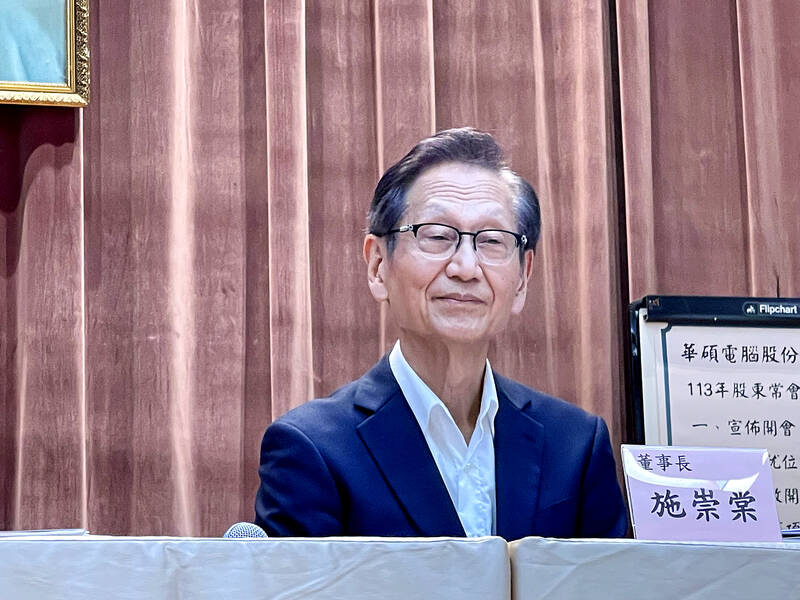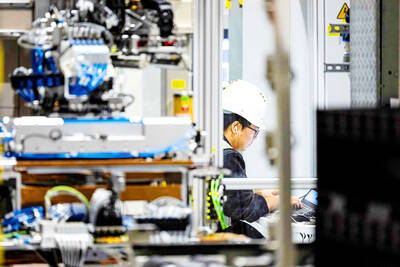PC vendor Asustek Computer Inc (華碩) yesterday said it is making better advances in expanding its server revenue over a five-year span to 2026, extending last quarter’s growth momentum.
Asustek fell behind its local peers in tapping into the server market, but its ambition to grow server revenue by five times within the 2022 to 2026 period looks more realistic after its strong performance in this year’s first quarter.
Server revenue increased several times last quarter from a year earlier to about NT$100 billion (US$3.1 billion), Asustek said.

Photo: Vanessa Cho, Taipei Times
“We are a latecomer to the server market, but we are making all-out efforts to achieve a better performance than we have announced,” Asustek chairman Jonney Shih (施崇棠) told reporters after the company’s annual shareholders’ meeting yesterday.
“There will be multiple times [of growth]. Besides, the timing is just ripe,” Shih said.
Asustek said it is confident that its server business would grow at a similar pace throughout this year, driven by robust demand for artificial intelligence (AI) servers.
The company counts some of the world’s major cloud server providers as its server clients.
Asustek said about 70 percent to 80 percent of its server revenue came from AI servers.
To play catch-up, Asustek has created a server team, which comprises more than 600 engineers.
The company said it aims to expand the team without giving any specific numbers.
Asustek said its server team is can compete with the nation’s major original design manufacturing (ODM) companies in developing high-quality products.
The company said it can equip servers with Nvidia Corp’s latest Blackwell GPU architecture.
Quanta Computer Inc (廣達), which makes AI servers powered by Nvidia’s AI chips, has the biggest server team among local ODM companies, with 2,200. Quanta aims to grow its server team by 10 percent this year to catch up with strong demand.
Asustek is also focusing on developing its AI robot ZenBo.
The company invested in AI robots a few years ago, but its development was “premature,” given inadequate computing power at the time, Shih said.
“There was no fundamental demand at the time, as it was not intelligent enough to interact with users,” Shih said. “Now, Asustek’s Zenbo can speak to users fluently and respond to their needs after being trained on big-language models”
“The timing is right,” he added.

CHIP RACE: Three years of overbroad export controls drove foreign competitors to pursue their own AI chips, and ‘cost US taxpayers billions of dollars,’ Nvidia said China has figured out the US strategy for allowing it to buy Nvidia Corp’s H200s and is rejecting the artificial intelligence (AI) chip in favor of domestically developed semiconductors, White House AI adviser David Sacks said, citing news reports. US President Donald Trump on Monday said that he would allow shipments of Nvidia’s H200 chips to China, part of an administration effort backed by Sacks to challenge Chinese tech champions such as Huawei Technologies Co (華為) by bringing US competition to their home market. On Friday, Sacks signaled that he was uncertain about whether that approach would work. “They’re rejecting our chips,” Sacks

It is challenging to build infrastructure in much of Europe. Constrained budgets and polarized politics tend to undermine long-term projects, forcing officials to react to emergencies rather than plan for the future. Not in Austria. Today, the country is to officially open its Koralmbahn tunnel, the 5.9 billion euro (US$6.9 billion) centerpiece of a groundbreaking new railway that will eventually run from Poland’s Baltic coast to the Adriatic Sea, transforming travel within Austria and positioning the Alpine nation at the forefront of logistics in Europe. “It is Austria’s biggest socio-economic experiment in over a century,” said Eric Kirschner, an economist at Graz-based Joanneum

BUBBLE? Only a handful of companies are seeing rapid revenue growth and higher valuations, and it is not enough to call the AI trend a transformation, an analyst said Artificial intelligence (AI) is entering a more challenging phase next year as companies move beyond experimentation and begin demanding clear financial returns from a technology that has delivered big gains to only a small group of early adopters, PricewaterhouseCoopers (PwC) Taiwan said yesterday. Most organizations have been able to justify AI investments through cost recovery or modest efficiency gains, but few have achieved meaningful revenue growth or long-term competitive advantage, the consultancy said in its 2026 AI Business Predictions report. This growing performance gap is forcing executives to reconsider how AI is deployed across their organizations, it said. “Many companies

France is developing domestic production of electric vehicle (EV) batteries with an eye on industrial independence, but Asian experts are proving key in launching operations. In the Verkor factory outside the northern city of Dunkirk, which was inaugurated on Thursday, foreign specialists, notably from South Korea and Malaysia, are training the local staff. Verkor is the third battery gigafactory to open in northern France in a region that has become known as “Battery Valley.” At the Automotive Energy Supply Corp (AESC) factory near the city of Douai, where production has been under way for several months, Chinese engineers and technicians supervise French recruits. “They